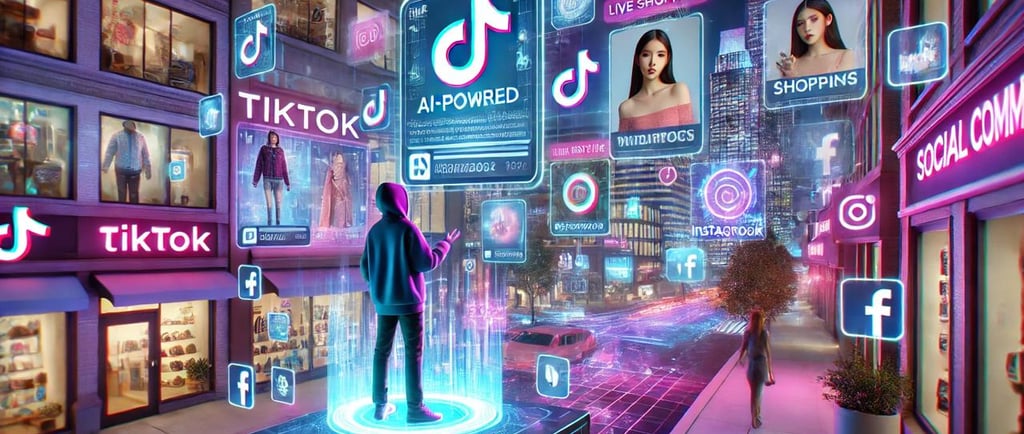Social Commerce: The Power of Social Media
Social media is no longer just a space for sharing memes and updates—it’s now a thriving marketplace. Social commerce, the fusion of social media and e-commerce, has revolutionized how brands engage customers and drive sales. By 2025, it’s projected to account for 17% of global e-commerce transactions and generate $1.2 trillion in sales. In this blog, we’ll explore why social commerce is essential, the trends shaping it, and actionable strategies to help your brand thrive.
Hessam Mahmoodi
2/7/20253 min read


What is Social Commerce?
Social commerce allows users to discover, engage with, and purchase products directly within social platforms like Instagram, TikTok, and Facebook. Unlike traditional e-commerce, which redirects users to external sites, social commerce streamlines the entire shopping journey—from discovery to checkout—within the app. This seamless integration reduces friction, boosts conversions, and fosters deeper brand loyalty .
---
Key Trends Shaping Social Commerce in 2025
1. Short-Form Video Dominance
Platforms like TikTok, Instagram Reels, and YouTube Shorts prioritize bite-sized, engaging videos. Brands that master the first 3 seconds of their content see higher engagement, with formats like tutorials, product demos, and behind-the-scenes clips driving sales . For example, Wendy’s uses humorous TikTok videos to showcase its brand personality, making content highly shareable .
2. User-Generated Content (UGC) as a Trust Engine
UGC accounts for 55.7% of TikTok’s content and drives 18% of creator revenue . Authentic reviews, unboxing videos, and customer testimonials build credibility, as consumers trust peers over polished ads. Brands like Glossier and ASOS leverage UGC to create relatable campaigns .
3. Live Shopping Events
Live-streamed shopping combines entertainment and commerce, with real-time interaction boosting conversion rates by 10% compared to traditional methods . For instance, Sephora uses live streams to demo products, answer questions, and offer exclusive discounts .
4. AI and Augmented Reality (AR)
AI-powered chatbots and AR try-on tools are transforming customer experiences. L’Oréal’s AR makeup filters let users virtually test products, while TikTok’s AI suite, Symphony, automates customer service and personalizes recommendations .
5. Micro-Influencers and Niche Communities
Micro-influencers (1K–100K followers) drive 47% higher engagement than celebrities by connecting with niche audiences. Brands like Gymshark partner with fitness influencers for authentic, long-term campaigns . Private communities on Discord or Facebook Groups also foster loyalty, with 60% of users more likely to stick with brands offering community access .
---
Strategies for Social Commerce Success
1. Optimize for Mobile and Platform-Specific Features
With 62.6% of the global population on social media , ensure your content is mobile-friendly and leverages platform tools like Instagram Shops, TikTok Shop, and Pinterest’s shoppable pins.
2. Prioritize Authenticity
Behind-the-scenes content, employee stories, and unfiltered posts resonate more than polished ads. Patagonia’s sustainability-focused storytelling and Apple’s privacy-first messaging build trust .
3. Leverage Data and Surveys
Use tools like Z.com’s surveys to understand consumer behavior, refine campaigns, and address checkout barriers. For example, analyzing drop-off rates can reveal UX improvements .
4. Invest in AI and Automation
AI tools like Metricool optimize posting times and generate tailored copy, while chatbots handle 24/7 customer inquiries, reducing response times .
5. Build Hybrid Experiences
Blend online and offline engagement with AR pop-up stores or virtual events. IKEA’s AR app, which lets users visualize furniture in their homes, is a prime example .
---
Challenges and Solutions
- Platform Uncertainty: TikTok’s potential U.S. ban and profitability struggles highlight the need for diversification. Focus on multi-platform strategies, such as Instagram Reels and YouTube Shorts .
- Consumer Fatigue: Combat ad saturation with value-driven content. For example, Nike’s live Q&A sessions educate while promoting products .
- Privacy Concerns: Transparent data policies and ethical marketing are critical. Apple’s emphasis on privacy has strengthened consumer trust .
---
The Future of Social Commerce
By 2028, social commerce is projected to hit $8.5 trillion, driven by Gen Z and millennials, who account for 58% of social media buyers . Brands that embrace authenticity, innovation, and community-building will lead this revolution.
---
Conclusion
Social commerce isn’t a trend—it’s the future of retail. By integrating shoppable content, leveraging AI, and fostering genuine connections, your brand can tap into a $1.2 trillion opportunity. Stay agile, experiment with new features, and let data guide your strategy. As Seth Godin said, “Marketing is no longer about the stuff you make but the stories you tell” .
Socials
Follow our socials for updates!
CONTACT
Connect
© 2025. All rights reserved @ MLT Marketerra Marketing Solutions.
